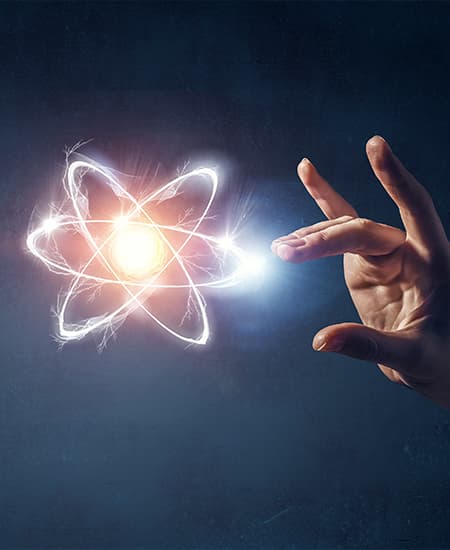Degree Structure
College
Sciences
Department
Applied Physics and Astronomy
Level
Undergraduate
Study System
Courses
Total Credit Hours
123 Cr. Hrs.
Duration
4 Years
Intake
Fall and Spring
Language
English
Study Mode
Full Time
Begin your academic journey with our user-friendly online application platform.
Important Dates
Get access to expert guidance.

Degree Overview
The BS in Applied Physics is designed in accordance with the mission and vision of the University of Sharjah and the College of Sciences to meet the needs of the students, the basic sciences community, and the UAE society at large. Quality and excellence in both the curriculum and instructional pedagogy are ensured by following high standard performance criteria. A student enrolled in this program must complete a total of 123 credit hours distributed as follows:
Study Plan
What You Will Learn
Upon the successful completion of the program, students should be able to:
- Identify, formulate, and solve broadly defined technical or scientific problems by applying knowledge of mathematics and science and/or technical topics to areas relevant to the discipline.
- Formulate or design a system, process, procedure or program to meet desired needs.
- Develop and conduct experiments or test hypotheses, analyze and interpret data and use scientific judgment to draw conclusions.
- Integrate the impact of technical and/or scientific physics solutions in a global, economic, environmental, and societal context.
- Communicate effectively with a range of audiences.
- Determine ethical and professional responsibilities related Physics applications.
- Function effectively on teams that establish goals, plan tasks, meet deadlines, and analyze risk and uncertainty.
University Requirements
College Requirements
Mandatory Courses
Every student in the College of Sciences irrespective of specialization is required to take the 15 credit hours of mandatory courses listed below:
| Course # | Course Title | Credit | Prerequisite |
| 1411115 | Programming I | 4 | None |
| 1430110 | Physics 1 for sciences | 3 | 1440131 |
| 1430116 | Physics 1 Lab | 1 | Pre/Co: 1430110 or 1430115 |
| 1420101 | General Chemistry I | 3 | None |
| 1420102 | General Chemistry I Lab | 1 | Pre/Co: 1420101 |
| 1440131 | Calculus I | 3 | None |
Elective Courses
The student must choose 6 credit hours outside the Department upon the approval of the academic advisor. The two elective courses are to be chosen from the table below.
| Course # | Course Title | CrHrs | Prerequisites |
| 0202207 | Technical Writing | 3 | 0202112 |
| 1450101 | General Biology I | 3 | None |
| 1440181 | Statistics for Science | 3 | None |
| 1440182 | Statistics for Science Lab | 1 | 1440181 |
Degree Requirements
| BS in Applied Physics (123 crs) | ||||
| UR | CR | PR | Total | - |
| Mandatory Credits | 18 | 15 | 44 | 74 |
| Electives Credits | 6 | 6 | 24 | 39 |
| Supporting Credits | - | - | 10 | 10 |
| Total | 24 | 21 | 78 | 123 |
Program Requirements
The program requirements consist of 78 credit hours of courses divided into four major sets as described below.
Mandatory Core Courses
This set consists of 44 credit hours encompassing the courses listed below.
| Course # | Course Title | Crs | Prerequisite |
| 1430100 | Physics Orientation | 1 | None |
| 1430117 | Physics 2 | 3 | Pre/Co: 1430110 or 1430115 1440131 or 1440133 |
| 1430118 | Physics 2 Lab | 1 | Pre/Co: 1430116, 1430117 |
| 1430221 | Classical Mechanics | 3 | 1430110 or 1430115; 1430251 |
| 1430241 | Modern Physics | 4 | 1430117; 1430118 |
| 1430251 | Mathematical Methods of Physics 1 | 3 | 1430110 or 1430115; 1440131 or 1440133 |
| 1430252 | Mathematical Methods of Physics 2 | 3 | 1430251 |
| 1430323 | Quantum Mechanics 1 | 3 | 1440241; 1430251 |
| 1430324 | Quantum Mechanics 2 | 3 | 1430323 |
| 1430331 | Electricity and Magnetism 1 | 3 | 1430117; 1430251 |
| 1430332 | Electricity and Magnetism 2 | 2 | 1340331 |
| 1430333 | Electronics for Experimental Physics 1 | 4 | 1430118 |
| 1430353 | Computational Physics | 3 | 1411116; 1430241 |
| 1430471 | Advanced Physics Lab | 3 | 1430241; 1430333 |
| 1430472 | Instrumentation and Control | 3 | 1430333 |
| 1430491 | Senior Project | 3 | Department consent |
Support Courses
This category includes 10 credit hours of Mathematics and Chemistry courses as indicated in the table below.
| Course # | Course Title | Crs | Prerequisite |
| 1440261 | Differential Equations for Engineers | 3 | - |
| 1440161 | Calculus II for Engineers | 3 | 1440131 |
| 1420103 | General Chemistry II | 3 | 0215102 |
| 1420104 | General Chemistry II Lab | 1 | Pre/Co 0215103 |
Elective Courses
Depending on the student interests and/or his/her future job prospects, the student selects in the senior year 24 credit hours from the following set of courses:
| Course # | Course Title | Crs | Prerequisite |
| 1430201 | Fundamentals of Astronomy Space Science | 3 | 1430110 or 1430115 |
| 1430202 | Celestial Mechanics | 3 | 1430110 or 1430115 |
| 1430211 | Physics 3 | 3 | 1430117 |
| 1430212 | Physics 3 Lab | 1 | 1430118; 1430211 |
| 1430261 | Thermodynamics | 3 | 1430110 or 1430115 |
| 1430301 | Astrophysics 1 (Stars) | 3 | 1430201 |
| 1430302 | Astronomical Techniques | 3 | 1430201 |
| 1430361 | Modern Optics | 3 | 1430211 |
| 1430362 | Thermal Physics | 3 | 1430211; 1430241 |
| 1430401 | Astrophysics 2 (Galaxies and the Universe) | 3 | 1430301 |
| 1430433 | Electronic for Experimental Physics 2 | 3 | 1430333 |
| 1430441 | Solid State Physics | 3 | 1430323 |
| 1430442 | Introduction to Radiation Physics Dosimetry | 3 | 1430241 |
| 1430443 | Nuclear Physics | 3 | 1430323 |
| 1430481 | Fundamentals of Environmental Physics | 3 | 1430241 |
| 1430482 | Physics of Materials | 3 | 1430261; 1430323 |
| 1430483 | Health Physics | 3 | 1430241 |
| 1430484 | Intro to Medical Imaging | 3 | 1430241 |
| 1430485 | Physics of Energy Resources | 3 | 1430241 |
| 1430486 | Photonics and Fiber Optics | 3 | 1430241; 1430361 |
| 1430487 | Radiation Biology | 3 | 1430241 |
| 1430488 | Meteorology | 3 | 1430241; 1430481 |
| 1430489 | Introduction to Spectroscopy | 3 | 1430323; 1430361 |
Course Description
| 1430100 | Physics Orientation | (1-0:1) |
|
A series of lectures on physics history, physical concepts, different fields of physics, physics-related careers, and the applied physics program and facilities at the University of Sharjah. Prerequisite: None |
||
| 1430110 | Physics 1 for sciences | (3-0:3) |
|
Motion in 1 and 2 dimensions, vectors, particle dynamics and Newton’s laws, work and energy, momentum and collisions, rotation of rigid bodies, fluid mechanics, heat and thermodynamics. Pre/Co-requisite: 1440131 |
||
| 1430116 | Physics 1 Lab | (0-3:1) |
|
10 experiments in mechanics, covering the topics in the Physics 1 course. Pre/Co-requisite: 1430110 or 1430115 |
||
| 1430117 | Physics 2 | (3-0:3) |
|
Charge and matter; electric field; Gauss’ law; electric potential; capacitors and dielectrics; current and resistance; electromotive force and circuits; magnetic field and forces; Ampere’s law; Faraday’s law of induction; introduction to Maxwell’s equations. Prerequisite: 1430110 or 1430115; Pre/Co-requisite: 1440131 or 1440133 |
||
| 1430118 | Physics 2 Lab | (0-3:1) |
|
10 experiments in electricity and magnetism, covering topics in the Physics II course. Prerequisite: 1430116; Pre/Co-requisite: 1430117 |
||
| 1430201 | Fundamentals of Astronomy & Space Science | (3-0:3) |
|
The course discusses astronomy in general and space science in particular with emphasis on using physics to interpret the motions involved in the universe (planets, stars, and galaxies) as well as the tools and methods used to observe the sky. Prerequisite: 1430110 or 1430115 |
||
| 1430202 | Celestial Mechanics | (3-0:3) |
|
This course treats Newtonian gravitation – how it manifests itself, how to calculate its effect on a variety of objects (artificial and natural satellites, planets, and stars), and how to utilize passive or active radar data to predict the future locations and velocities of such objects. It discusses Newton’s Laws of motion and law of gravitation as applied to system of particles; motion in the gravitation field with an especially full discussion of the two body problem; coordinates systems and time systems; data reduction; initial orbit determination; the differential correction of orbits, and perturbation theory. Astrophysical applications of classical gravitation to binary stars, clusters of stars, and clusters of galaxies. Prerequisite: 1430110 or 1430115 |
||
| 1430211 | Physics 3 | (3-0:3) |
|
Rotation of rigid bodies, Dynamics of Rotational motion, Equilibrium and Elasticity, Periodic Motion, Fluid Mechanics, Mechanical Waves, Sound and Hearing, Thermal properties of Matter, introduction to the First and 2nd law of thermodynamics. Prerequisite: 1430117 |
||
| 1430212 | Physics 3 Lab | (0-3:1) |
|
5-8 selected experiments on the topics mentioned in the description of the theoretical part of physics 3. Prerequisite: 1430118; Pre/Co-requisite: 1430211 |
||
| 1430221 | Classical Mechanics | (3-0:3) |
|
Newtonian mechanics of particles and systems, conservation laws, oscillations, Lagrangian mechanics, central force, motion in non-inertial frames, and motion of rigid bodies. Prerequisite: 1430110 or 1430115 and 1430251 |
||
| 1430241 | Modern Physics | (3-3:4) |
|
Special theory of relativity and relativistic mechanics; photons; x-rays and the Compton effect; the Bohr model of hydrogen; de Broglie wavelength of matter and wave packet description of particles; Schrödinger wave equation in one dimension; energy quantization; the Spin and many-electron atoms; elements of nuclear physics and elementary particles. It includes 12 experiments covering the topics above. Prerequisite: 1430117 and 1430118 |
||
| 1430251 | Mathematical Methods of Physics 1 | (3-0:3) |
|
Infinite series, complex numbers, linear equations, vectors and vector analysis, matrices and matrix transformation, partial differentiation, multiple integrals, and vector spaces. Prerequisite: 1440131 or 1440133 and 1430110 or 1430115 |
||
| 1430252 | Mathematical Methods of Physics 2 | (3-0:3) |
|
Tensor analysis, Calculus of variations, special functions, integral transforms, series solutions of differential equations, Partial Differential equations, complex variable theory. Prerequisite: 1430251 |
||
| 1430261 | Thermodynamics | (3-0:3) |
|
Entropy and the chemical potential, independent variables and state functions, basic energy concepts first and second laws of thermodynamics; ideal and real gases; thermodynamic properties; introductory cycle analysis. Prerequisite: 1430110 or 1430115 |
||
| 1430281 | Physics for Medical Imaging | (3-1:4) |
|
Energy and matter (the relation between them) temperature and heat, charge and electric field, electrical potential, capacitors and dielectrics, current and resistance, electromotive force and circuits, magnetism and electromagnetism, electromagnetic induction, thermoionic emission, x-ray tube, electromagnetic radiation, electromagnetic spectrum, x-ray and gamma ray interaction with matter, radiation safety and dosimetry. Various experiments covering the topics mentioned in physics for medical imaging course such as surface tension, magnetic fields, geometrical optics, oscilloscope, capacitors, the speed of light, the photo-electric effect, thermal radiation, specific charge of the electron, spectrum of the Hydrogen atom, Frank-Hertz experiment, and nuclear radiation measurements. Prerequisites: 1430107 or 1430111 and 1430112 |
||
| 1430283 | Physics for Dentistry | (3-3:4) |
|
The course covers physics topics related to dental applications. These include biomechanics of the jaw, light and optics, atomic structure, spectra, radioactivity, x-rays (generation, safety and protection), bioelectricity, lasers, imaging, waves and ultrasound. Prerequisite: 1430107 or 1430111 and 1430110 or 1430115 |
||
| 1430301 | Astrophysics 1 (Stars) | (3-0:3) |
|
Astrophysics is the application of physics to understand and interpret the art of observation and the measurement side of astronomy. This course will help tie astronomy to the different physics concepts that the student has experienced as a physics student. The main goal of this course is to help the students see that astrophysics is not just a high technology research branch, but as part of everyday living. Prerequisite: 1430201 |
||
| 1430302 | Astronomical Techniques | (3-0:3) |
|
This course provides a comprehensive and accessible introduction to the whole of modern astrophysics beyond the solar system. It combines a critical account of observational methods (telescopes and instrumentation) with a clear description of the Universe, including stars, galaxies and cosmology. The course describes the techniques used by astronomers to observe the Universe: optical telescopes and instruments are discussed in detail, but observations at all wavelengths (from gamma rays to radio) are covered, and there are sections on cosmic rays, neutrinos and gravitation waves. After a short interlude describing the appearance of the sky at all wavelengths, the role of positional astronomy is highlighted. Student will learn here the quantitative aspects of the electromagnetic spectrum, atmospheric absorption, celestial coordinate systems, the motions of celestial objects, eclipses, calendar and time systems, telescopes in all wavebands, speckle interferometry and adaptive optics to overcome atmospheric jitter, astronomical detectors including CCDs, interferometry to improve angular resolution, radiation from point and extended sources, the determination of masses, temperatures, and distance of celestial objects. Moreover, a clear description is given to the contents of the Universe, including accounts of stellar evolution and cosmological models. In addition to all of this, the student will utilize methods for data reduction and statistical analysis. Prerequisite: 1430201 |
||
| 1430323 | Quantum Mechanics 1 | (3-0:3) |
|
Schrodinger’s equation; the correspondence principle; the uncertainty principle; 1- potentials; the harmonic oscillator; the hydrogen atom; elements of matrix mechanics; operators; angular momentum. Prerequisites: 1430241 and 1430251 |
||
| 1430324 | Quantum Mechanics 2 | (3-0:3) |
|
Orbital angular momentum, radial wave function in three dimensions, eigenstates, commutation relations of the spin angular momentum operator, interaction of spin with angular momentum, behavior of electrons in a magnetic field, perturbation theory, approximation methods for time-dependent problems. Prerequisite: 140323 |
||
| 1430331 | Electricity and Magnetism 1 | (3-0:3) |
|
Electrostatics: Poisson’s equation; energy in the electric field; electrostatics of materials; Magnetostatics: Vector potential; energy in the magnetic field; magneto-statics of materials; Faraday’s law; inductance; solutions to the Laplace equation; Maxwell equations. Prerequisite: 1430117 and 1430251 |
||
| 1430332 | Electricity and Magnetism 2 | (2-0:0) |
|
Electromagnetic induction, electromagnetic wave propagation, absorption and dispersion in conductors and dielectrics, EM wave transmission, potentials and fields, EM radiation. Prerequisite: 1430331 |
||
| 1430333 | Electronics for Experimental Physics 1 | (3-3:4) |
|
Linear circuit theory; diodes and power supplies; transducers; analog integrated circuits: including filters and operational amplifiers; digital integrated circuits including: basic gates; combinational and sequential logic; storage elements; timing elements; arithmetic devices; digital-to-analog and analog-to-digital conversion. It includes 12 experiments covering the topics mentioned above. Prerequisite: 1430118 |
||
| 1430353 | Computational Physics | (2-3:3) |
|
Techniques in the use of personal computers in physics including: numerical modeling and integration, processing of large data sets; experience in the use of statistical techniques to analyze data and to model physical events; the use of mathematical packages. Laboratory: hands-on experience in the use of PCs in solving physics problems. Prerequisite: Third Year Standing Prerequisite: 1430241 and 141116 |
||
| 1430361 | Modern Optics | (3-0:3) |
|
Physical optics with major emphasis on wave properties of light; boundary conditions; dispersion; optics of thin films; interference; diffraction; polarization; lasers; holography; Fourier analysis. Prerequisite: 1430211 |
||
| 1430362 | Thermal Physics | (3-0:3) |
|
Equations of state; the first law of thermodynamics; heat engines and refrigerators; entropy and the second law of thermodynamics; phase equilibrium; kinetic theory; equipartition theory; transport phenomena; introduction to statistical mechanics including quantum statistics; applications to black body radiation, crystalline vibrations, magnetic ions in solids, electronic heat capacity of metals, phase transformations and chemical reactions. Prerequisite: 1430211 and 1430241 |
||
| 1430401 | Astrophysics 2 (Galaxies and the Universe) | (3-0:3) |
|
The course will focus on the physical properties of the planets to infer their origin and evolution. It first takes a comparative look at our current knowledge of the planets, especially our Earth, moon, as well as Mercury, Venus, and Mars. We will examine here the composition and internal structure of the terrestrial planets and describe the major surface-shaping processes: planetary volcanism, impact cratering and wind processes. The atmosphere of the terrestrial planets is considered in detail, and this leads naturally to a discussion of the giant planets and why they are compositionally different from the planets of the inner Solar System. Description is given of the origin of the Solar System and the evolution of the planets, and places our own planet Earth within the context of other, more distant worlds. Minor bodies, including comets, asteroids and Kuiper Belt objects, are described, and the course concludes with an examination of theories for the origin of the Solar System and the evidence that has come from meteorites. Prerequisite: 1430301 |
||
| 1430433 | Electronics for Experimental Physics 2 | (3-0:3) |
|
Introduction to the electronic theory of semiconductors, semiconductors in equilibrium, the ideal p-n junction, non-idealities, photo diodes, LEDs, semiconductor lasers, metal-semiconductor contacts, heterojunctions, JFET, MOST, small signal parameters, switching, and Thyristors. Prerequisite: 1430333 |
||
| 1430441 | Solid State Physics | (3-0:3) |
|
Introduction to atomic structure and bonding in solids; reciprocal lattice and x-ray crystallography; phonons and crystal vibrations; phonons and thermal properties; classical free electron behavior of metals; energy bands in metals, semiconductors and insulators. Pre-requisite: 1430323 |
||
| 1430442 | Introduction to Radiation Physics and Dosimetry | (3-0:3) |
|
Radiation from accelerated charges; characteristics and quality of X-rays; attenuation of photon beams in matter; interactions of photons with matter; interaction of charged particle beams with matter; concepts of dosimetry; radiation spectrometry. Prerequisite: 1430241 |
||
| 1430443 | Nuclear Physics | (3-0:3) |
|
Basic properties and structure of atomic nuclei, introduction to nuclear models, nuclear reactions, decay and stability, the four basic interaction - strong, electromagnetic, weak and gravitational, properties of - baryons, mesons, quarks, and leptons -, conservation laws, symmetries and broken symmetries, the standard model, experimental techniques. Prerequisite: 1430323 |
||
| 1430471 | Advanced Physics Lab | (0-6:2) |
|
Zeeman effect, UV spectroscopy, optical spectroscopy, ionizing radiation, crystal structure, gamma spectroscopy, elastic properties of materials, absolute radioactivity, thermal properties of materials, measuring blood speed by Doppler ultrasound, radiation Pollution. Prerequisite: 1430333 and 1430241 |
||
| 1430472 | Instrumentation and Control | (1-4:3) |
|
Instrumentation methodology and sensors; fundamentals of pressure, temperature, level, and flow systems; pneumatic, mechanical, and electronic digital transducers; calibration and basic maintenance of industrial instrumentation equipment; training on the use of graphical software systems for developing high-performance scientific and engineering applications such as Lab VIEW or Test Point which acquire data and control devices via IEEE-488 (GPIB), RS-232/422 and modular (CAMAC) instruments as well as plug-in I/O boards. Prerequisite: 1430333 |
||
| 1430481 | Environmental Physics | (3-0:3) |
|
Relationship of physics to current environmental problems; energy production, comparison of sources and byproducts; nature of and possible solutions to problems of various pollutions particularly matter in atmosphere; radiation physics; the climate; spectroscopy and instrumentation. Prerequisite: 1430241 |
||
| 1430482 | Physics of Materials | (3-0:3) |
|
Advanced topics in elasticity, viscous flow, reaction kinetics, thermal properties, heat transfer, mechanical properties and optical properties of materials. Prerequisite: 1430261 and 1430323 |
||
| 1430483 | Health Physics | (3-0:3) |
|
Sources of radiation, basic dosimetry and hazards of ionizing radiation. Techniques for detection, use and safe handling of radiation sources. Radiation safety codes laws and regulations. Prerequisite: 1430241 |
||
| 1430484 | Introduction to Medical Imaging | (2-3:3) |
|
Fundamentals of image formation, analysis of the characteristics of medical images, parametric description of image quality, application to transmission of radiotherapy. Prerequisite: 1430241 |
||
| 1430485 | Physics of Energy Resources | (3-0:3) |
|
Energy and environment; the economics of energy; traditional energy sources: fossil fuels; nuclear energy; sustainable and renewable energy; wind and solar power systems; hydroelectric and geothermal energy; energy storage and transportation. Prerequisite: 1430241 |
||
| 1430486 | Photonics and Fiber Optics | (3-0:3) |
|
Models of light, optical fiber basics, optical fiber manufacture, incoherent light sources, laser light, light detectors, detector circuit and modulation, fiber optics transmitters and receivers, fiber optics telecommunications, interferometric fiber optic sensors. Prerequisite: 1430241 and 1430361 |
||
| 1430487 | Radiation Biology | (3-0:3) |
|
Basic radiation physics, track structure, radiation chemistry, DNA damage and repair, cell survival curves, the 4R’s of radiology, radiation therapy, radiation effects, radiation protection. Prerequisite: 1430241 |
||
| 1430488 | Meteorology | (3-0:3) |
|
Fundamental concepts, earth and the atmosphere, warming the earth, daily and seasonal temperatures, atmospheric optics, atmospheric moisture, condensation, stability and cloud, precipitation, motion of the atmosphere, winds, air masses and fronts, cyclones, thunderstorms, tornadoes, hurricanes, air pollution, global climate and its changes, weather forecasting. Prerequisite: 1430241 and 1430481 |
||
| 1430489 | Introduction to Spectroscopy | (3-0:3) |
|
Electromagnetic radiation and its interaction with atoms and molecules; experimental methods; molecular symmetry; rotational, vibrational and electronic spectroscopy; photoelectron and related spectroscopies; lasers and laser spectroscopy. Prerequisite: 1430361 and 1430323 |
||
| 1430491 | Senior Project | (0-6:3) |
|
Under the supervision of a faculty member, the student gets involved in a project and writes a report about a topic approved by the department, and defends it publicly. Prerequisite: Department consent |
||
Career Path
Graduates of our Applied Physics program find diverse employment avenues. Physics graduates can explore opportunities in hospitals, environmental agencies, industrial and medical labs, energy and water resource corporations, military and police sectors, as well as the oil and gas industries. Additionally, they can contribute to communications and work in sales and research centers.
Furthermore, graduates from the Education and Applied Physics program can take up roles in teaching, educational supervision, and administrative supervision, contributing to the education sector.

How will you make an impact?
Every student’s journey at UoS and beyond is different, which is why our Career & Professional Development team provides personalized career resources to help students make an impact for years to come.





